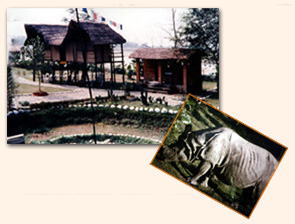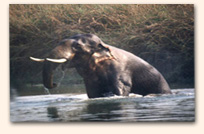|
| Introduction
of safari: |
|
|  Nepal
is a land of extreme contrasts in climate and geography. It
has a unique topographyranging from lowlands with sub-tropical
jungles to arctic conditions in the Himalayan highlands. Within
a mere 150 kilometers, the land rises from near sea level
in the south to over 8,000 meters in the north. This together
with the monsoon rainfall along the south facing slopes has
resulted in compacting virtually all climate zones found on
planet earth. as result , Nepal has been endowed with the
great diversity of life- zones providing a home for a large
variety , birds and animals. Nepal
is a land of extreme contrasts in climate and geography. It
has a unique topographyranging from lowlands with sub-tropical
jungles to arctic conditions in the Himalayan highlands. Within
a mere 150 kilometers, the land rises from near sea level
in the south to over 8,000 meters in the north. This together
with the monsoon rainfall along the south facing slopes has
resulted in compacting virtually all climate zones found on
planet earth. as result , Nepal has been endowed with the
great diversity of life- zones providing a home for a large
variety , birds and animals.
Terai lowland is the richest
habitat with the tall grasslands interspersed with reverie
and hardwood sal forest. Here one can see wild life such as
the swamp deer, musk deer, black buck, blue bull, and the
Royal Bengal tiger, Gharial and mugger crocodiles, and the
last of a breed of Asiatic wild buffalo. This area is also
rich in birdlife with verity of babblers and orioles, Koles
and drongos , peacocks and floricans, and a multitude of wintering
wildfowl.
Once one if the most famous
big game hunting areas in Asia , Chitwan National park now
offers protection to a large array of mammals such as the
one- horned rhinoceros, tiger , leopard, sloth bear and the
gaur ( wild bison ) as well as more then 400 species of birds. |
| Royal Chitwan
National Park: |
 Nepal`s
first and most famous National park is situated in the Chitwan
Doon or the lowlands of the innerTerai. Covering an area of
932 sq. km. The park includes hilly areas of the Siwalik range
covered by deciduous sal forest. A fifth of the park is made
up of the floodplains of the Narayani , Rapti and the Rue
rivers and is covered by dense tall elephant grass interspersed
with riverine forests of silk cotton( Kapok) , acacia and
sisam trees. Chitwan also supports a great variety of flora
and fauna. There are four specious of deer, including the
spotted chittal, leopard, sloth bear, wild boar etc.. The
swampy areas and numerous ox-bow lakes of Chitwan provide
a home for marsh crocodiles. Here is also found one one of
the worlds four species of fresh water dolphins. Nepal`s
first and most famous National park is situated in the Chitwan
Doon or the lowlands of the innerTerai. Covering an area of
932 sq. km. The park includes hilly areas of the Siwalik range
covered by deciduous sal forest. A fifth of the park is made
up of the floodplains of the Narayani , Rapti and the Rue
rivers and is covered by dense tall elephant grass interspersed
with riverine forests of silk cotton( Kapok) , acacia and
sisam trees. Chitwan also supports a great variety of flora
and fauna. There are four specious of deer, including the
spotted chittal, leopard, sloth bear, wild boar etc.. The
swampy areas and numerous ox-bow lakes of Chitwan provide
a home for marsh crocodiles. Here is also found one one of
the worlds four species of fresh water dolphins. |
| Access: |
Chitwan
is easily accessible from highway to Bharatpur and sauraha.
There are daily flights from Kathmandu to Bharatpur . Another
exciting alternative is a one to three days raft trip down
the Trishuli river to Narayanghat or directly into the western
edge of the park. Visiters can stay in one of the several
lodges and camps inside or outside the park. |
| Our Tentative
Programs: |
Most
of the lodges are simple from outside, with mud walls with
comfortable double-bedded rooms having hot and cold running
water. The rustic design of the buildings is in perfect harmony
with the total wilderness and completely isolated surroundings.
|
| 01 nights
02 days: |
|
| |
| Day
01: |
| Upon
arrival wel come drink and short briefing about
program. |
| 13.00
Lunch served |
| 14.00
Culture tour to Tharu Village |
| 16.00
Sunset viewing |
| 18:00
Tharu stick dance |
| 19.00
Dinner served |
|
|
|
| Day
02: |
| 5.30
AM wake -up call. |
| 6.30
AM breakfast served |
| 7.50
AM Elephant back safari-Bird watching or jeep drive
(it depends on the time of the year.) |
| 18:00
Tharu stick dance |
| 19.00
Dinner served |
| 10.30
AM final departure to Kathmandu or to Pokhara or
to Indian Border |
|
|
| 02 nights
03 days: |
|
| |
|
1st
day |
| Upon
arrival wel come drink and short briefing about
program. |
| 13.00
Lunch served |
| 14.00
Culture tour to Tharu Village |
| 16.00
Sunset viewing |
| 18:00
Tharu stick dance |
| 18:00
Tharu stick dance |
| 19.00
Dinner served |
|
|
|
| |
|
2nd
day |
| 5.30
AM Wake up call |
| 6.00
tea / coffee |
| 6:30
start elephant safari or jeep drive |
| 8.30
Breakfast served |
| 9.15
Canoe ride/ elephant briefing and swimming and bath.. |
| 1.0
PM lunch served |
| 2.0
PM Rest hour |
| 3.0
PM nature/ jungle walk - visit to observation tower
|
| 6.00
PM Slide show program |
| 7.30
PM dinner served.. |
|
|
|
| |
|
3rd Day |
| 5.30
AM wake -up call. |
| 6.30
AM breakfast served |
| 7.50
AM Bird watching program |
10.30
AM final departure or earlier or little later …to
Kathmandu or to
Pokhara or to Indian Border |
|
|
|
| 03 nights
04 days: |
|
| |
|
Receive, wel- come drink and briefing by the
lodge manager. |
| 1st
Day |
| 1:00
PM arrival -Lunch served. |
| 2:00
PM Elephant ride / nature walk / visit to tower |
| 4.00
PM village visiting |
| 7.00
PM dinner served |
|
|
|
| |
|
2nd Day |
| 5.30
AM Wake up call |
| 6.00
tea / coffee |
| 6:30
start elephant safari / bird watching |
| 8.30
Breakfast served |
| 9.15
Canoe ride/ elephant briefing and swimming and bath.. |
| 4.0
PM lunch served |
| 5.0
PM Rest hour |
| 6.0
PM nature walk - visit to observation tower |
| 6.00
PM Tharu stick dance program |
| 7.30
PM dinner served.. |
|
|
|
| |
|
3rd Day |
| Wake
up call |
| Tea
/coffee |
| Bird
watching |
| Jeep
drive |
| 20,000
lake visiting by bicycle or Jeep |
| Lunch
|
| Slide
show |
| Dinner
|
|
|
|
| |
|
4th Day |
| Bird
watching or jungle walks |
| Breakfast |
| Final
departure to Kathmandu or to Pokhara or to Indian
Border |
|
|
| What to see: |
| Vegetation:Shorea
Kobusta (sal) 70%, grassland 20%, reverie forest (sishoo, Khair,
etc) 7%, Pinus Rox Burgii 3%.Animals:One horned Rhinoceros,
the Royal Bengal Tiger, Wild Boar, Gour, Neelgai (Blue Cow),
wild elephant, Antelope, Striped Hyena, Pangolin, Chital, Hog
Deer, Barking Deer, Common leopard, Sloth Bear, Rate, palm Civet,
Wild Dog, Langur, etc. Reptiles like the Lizard, Python, Cobra,
etc and more than 45 species of amphibians.Birds:450 Species
of birds like Bengal Horizon, giant hornbill and black and white
stork, Peacock, Red Jungle fowl, Heron, Kingfisher, wood Peacker,
flycatcher etc. |
| When to visit: |
| The
best time to visit the park is October - November in fall and
mid February - mid May in summer. |
| Royal Bardia
National Park: |
|  The
Royal Bardia National Park is situated
one the eastern banks of the Karnali river , about 400 kms,
west of Kathmandu . The park is 968sq. kms. In area extends
from Churia hills southward to the gentle slopes of the Bhabhar,.
The western end of the Bardia is bounded by numerous water
-ways of the Karnali river which have created many large and
small gravel islands. The
Royal Bardia National Park is situated
one the eastern banks of the Karnali river , about 400 kms,
west of Kathmandu . The park is 968sq. kms. In area extends
from Churia hills southward to the gentle slopes of the Bhabhar,.
The western end of the Bardia is bounded by numerous water
-ways of the Karnali river which have created many large and
small gravel islands.
Bardia is the home of wide variety
of animals, many of which live in and around the Phantas.
These open grasslands such as Baghora and Lamkoili are the
best places to view animals. The most conspicuous of which
is the spotted deer. Other ungulates include black buck ,
hog deer , samber deer, wild boar and Barasingha or swamp
deer. Two species of monkeys , the langur and the rhesus macaque
are also present . The park is famous for its small herds
of wild elephants which are rarely seen. The Park also boasts
a small population of the rare gharial , the marsh mugger
crocodile and the Gangetic dolphin. The island of the Karnali
river harbours the sub -continents largest antelope species
, the Nelgai or Blue bull. More then 350 specious have been
recorded in Bardia, truly a bird watcher`s paradise.
|
| Access: |
| To
reach Bardia, take the daily air flight or public day or night
bus from Kathmandu to Nepalgunj , from where it is five hour
drive by jeep to the camp area. This nature sanctuary is best
visit from October to April however it is hot during the months
from April - August. |
| Our
Tentative Programs: |
| |
| 03
night's 04 days fly in fly out (Kathmandu - Nepaljung
- Kathmandu or Pokhara. |
| 04
night's 05 days drive in fly out or both ways drives. |
| 05
nights 06 days |
| 07
nights 08 days (With Karnali Rafting) |
|
|
| What
to see: |
Vegetation:The
Park contains 70% of shorea Robusta and the remaining 30%
is covered with the balance mixture of grasslands and reverie
woods.
Animals:The wild Boar, Hog Deer, Blue Bull, Porcupine, sloth
bear, wild dog, Mongoose, civets, jungle cats, Rhesus Monkey,
Barking Deer, Sambar Deer Otter, Jackal, Hyena, Common Leopard.
Fishing cat, Langur Monkey etc. are commonly seen.
Birds:The Woodpecker (10 species), Heron (5 species), Bulbul
(5 species), Dove (5 species), Egret (4 species), Parakeets,
King fisher, Bee Eater, Barbet, Pigeion, Stork, Sunbird, Babbler,
Warble, flycatcher and Bar-headed Goose are seen in this park. |
| When
to visit: |
| The
best seasons to visit the park are fall (October - November)
and spring (mid February - April). |
| How
to travel: |
| There
is a daily domestic flight to Nepalgunj from Kathmandu Airport.
This national Park can be reached by surface route only. So
after reaching Nepalgunj, Public bus services wait us to the
far west Terai. |
|
|
|
 |



